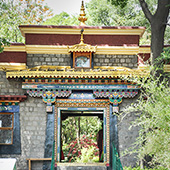Home / Resources / Norbulingka Institute - Sidhpur / Handicrafts At Norbulingka Institute / Wood Painting
Design Resource
Norbulingka Institute - Sidhpur
Tibetan Art and Culture
by
Kyumbur is the Tibetan name for a distinctive kind of wood paintings done on furniture and walls of shrines. This is an embossing technique that almost appears to pop out in a three-dimensional form. Traditionally, a mixture of lime and molasses squeezed through a tube was used to outline the drawings, but later Norbulingka introduced improved techniques to make the process easy and the work durable. In the workshop, the artists are made to use a syringe to apply the mixture and carpenter’s glue for clearer outlines. An extremely steady hand is very much needed for this task, which takes months of practice. For the best results, artists are expected to trace the design rightly while ensuring a consistent flow of paste through the syringe. When the outline dries, the artist starts with the painting process. At Norbulingka, students complete a series of simple paintings within 1 to 5 days, starting their practice on cardboards and then moving to wooden hangings. The price range of the products starts from rupees 2,800 to 5,000.










